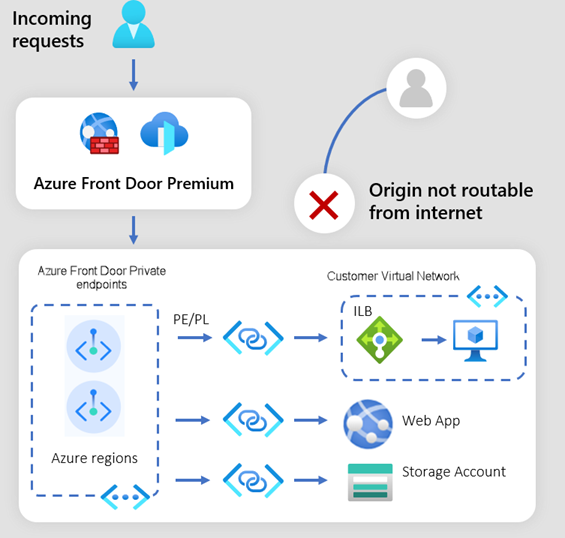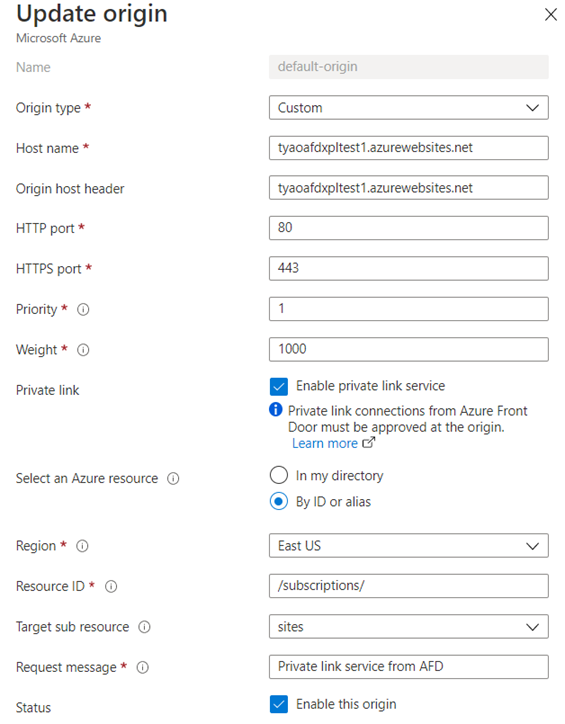Secure your Origin with Private Link in Azure Front Door Premium
Azure Private Link enables you to access Azure PaaS services and services hosted in Azure over a private endpoint in your virtual network. Traffic between your virtual network and the service goes over the Microsoft backbone network, eliminating exposure to the public Internet.
Azure Front Door Premium can connect to your origin using Private Link. Your origin can be hosted in a virtual network or hosted as a PaaS service such as Azure Web App or Azure Storage. Private Link removes the need for your origin to be accessed publicly.

How Private Link works
When you enable Private Link to your origin in Azure Front Door Premium, Front Door creates a private endpoint on your behalf from an Azure Front Door managed regional private network. You receive an Azure Front Door private endpoint request at the origin pending your approval.
Important
You must approve the private endpoint connection before traffic can pass to the origin privately. You can approve private endpoint connections by using the Azure portal, Azure CLI, or Azure PowerShell. For more information, see Manage a Private Endpoint connection.
After you enable an origin for Private Link and approve the private endpoint connection, it can take a few minutes for the connection to be established. During this time, requests to the origin receives an Azure Front Door error message. The error message goes away once the connection is established.
Once your request is approved, a private IP address gets assigned from the Azure Front Door managed virtual network. Traffic between your Azure Front Door and your origin communicates using the established private link over the Microsoft backbone network. Incoming traffic to your origin is now secured when arriving at your Azure Front Door.

Supported origins
Origin support for direct private endpoint connectivity is currently limited to:
- Blob Storage
- Web App
- Internal load balancers, or any services that expose internal load balancers such as Azure Kubernetes Service, Azure Container Apps or Azure Red Hat OpenShift
- Storage Static Website
- Application Gateway (Public Preview. Don't use in production environments)
- API Management (Public Preview. Don't use in production environments)
- Azure Container Apps (Public Preview. Don't use in production environments)
Note
- This feature isn't supported with Azure App Service Slots or Functions.
Region availability
Azure Front Door private link is available in the following regions:
| Americas | Europe | Africa | Asia Pacific |
|---|---|---|---|
| Brazil South | France Central | South Africa North | Australia East |
| Canada Central | Germany West Central | Central India | |
| Central US | North Europe | Japan East | |
| East US | Norway East | Korea Central | |
| East US 2 | UK South | East Asia | |
| South Central US | West Europe | ||
| West US 3 | Sweden Central | ||
| US Gov Arizona | |||
| US Gov Texas | |||
| US Gov Virginia |
The Azure Front Door Private Link feature is region agnostic but for the best latency, you should always pick an Azure region closest to your origin when choosing to enable Azure Front Door Private Link endpoint. If your origin's region is not supported in the list of regions AFD Private Link supports, pick the next nearest region. You can use Azure network round-trip latency statistics to determine the next nearest region in terms of latency.
Association of a private endpoint with an Azure Front Door profile
Private endpoint creation
Within a single Azure Front Door profile, if two or more Private Link enabled origins are created with the same set of Private Link, resource ID and group ID, then for all such origins only one private endpoint gets created. Connections to the backend can be enabled using this private endpoint. This setup means you only have to approve the private endpoint once because only one private endpoint gets created. If you create more Private Link enabled origins using the same set of Private Link location, resource ID, and group ID, you don't need to approve anymore private endpoints.
Single private endpoint
For example, a single private endpoint gets created for all the different origins across different origin groups but in the same Azure Front Door profile as shown in the following table:

Multiple private endpoints
A new private endpoint gets created in the following scenario:
If the region, resource ID or group ID changes:

Note
The Private Link location and the hostname has changed, resulting in extra private endpoints created and requires approval for each one.
When the Azure Front Door profile changes:

Note
Enabling Private Link for origins in different Front Door profiles will create extra private endpoints and requires approval for each one.
Private endpoint removal
When an Azure Front Door profile gets deleted, private endpoints associated with the profile also get deleted.
Single private endpoint
If AFD-Profile-1 gets deleted, then the PE1 private endpoint across all the origins also gets deleted.

Multiple private endpoints
If AFD-Profile-1 gets deleted, all private endpoints from PE1 through to PE4 gets deleted.

Deleting an Azure Front Door profile doesn't affect private endpoints created for a different Front Door profile.

For example:
- If AFD-Profile-2 gets deleted, only PE5 is removed.
- If AFD-Profile-3 gets deleted, only PE6 is removed.
- If AFD-Profile-4 gets deleted, only PE7 is removed.
- If AFD-Profile-5 gets deleted, only PE8 is removed.
Next steps
- Learn how to connect Azure Front Door Premium to a Web App origin with Private Link.
- Learn how to connect Azure Front Door Premium to a storage account origin with Private Link.
- Learn how to connect Azure Front Door Premium to an internal load balancer origin with Private Link.
- Learn how to connect Azure Front Door Premium to a storage static website origin with Private Link.
- Learn how to connect Azure Front Door Premium to an application gateway origin with Private Link.
- Learn how to connect Azure Front Door Premium to an API Management origin with Private Link.
- Learn how to connect Azure Front Door Premium to an Azure Container Apps origin with Private Link.